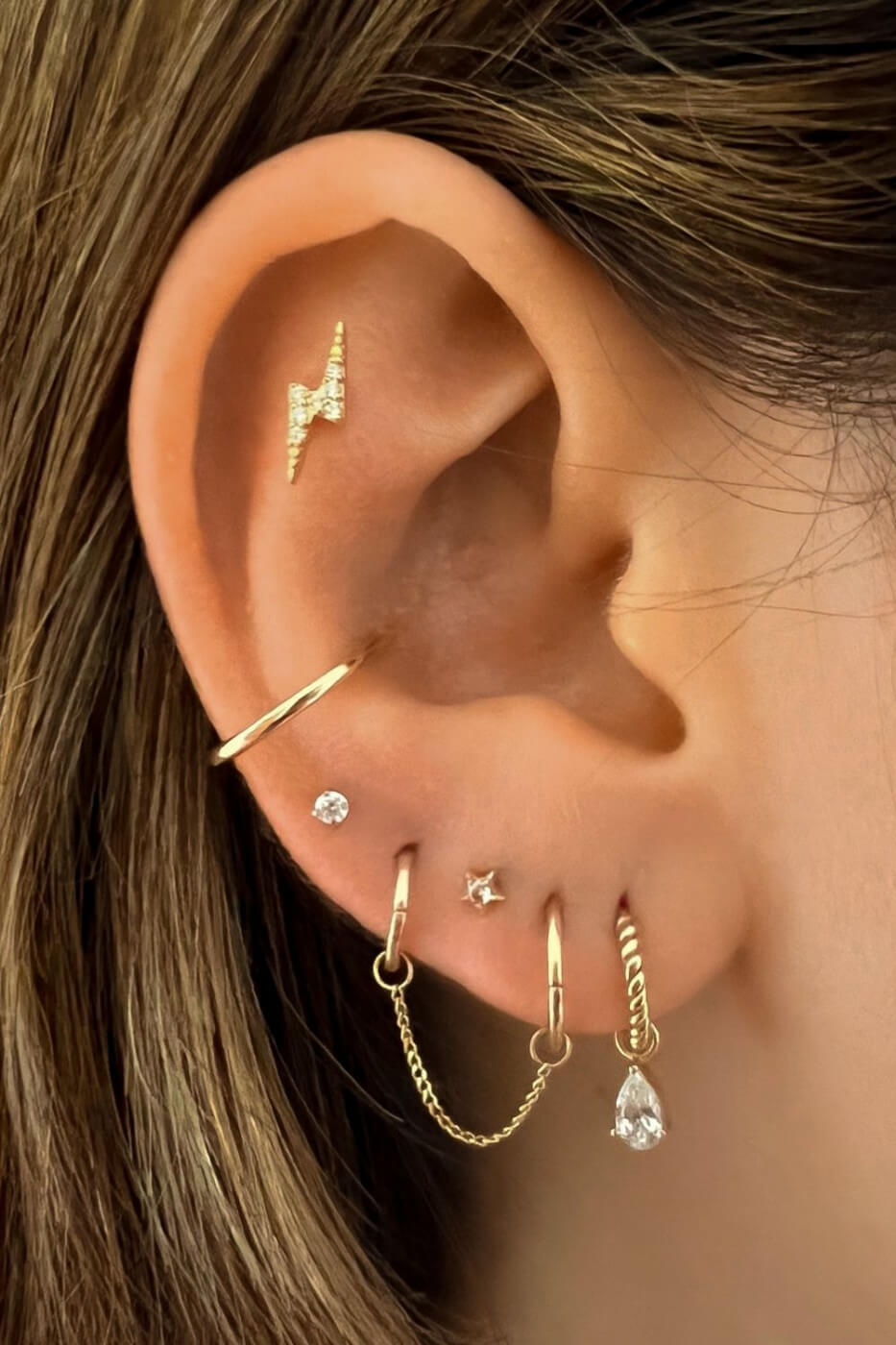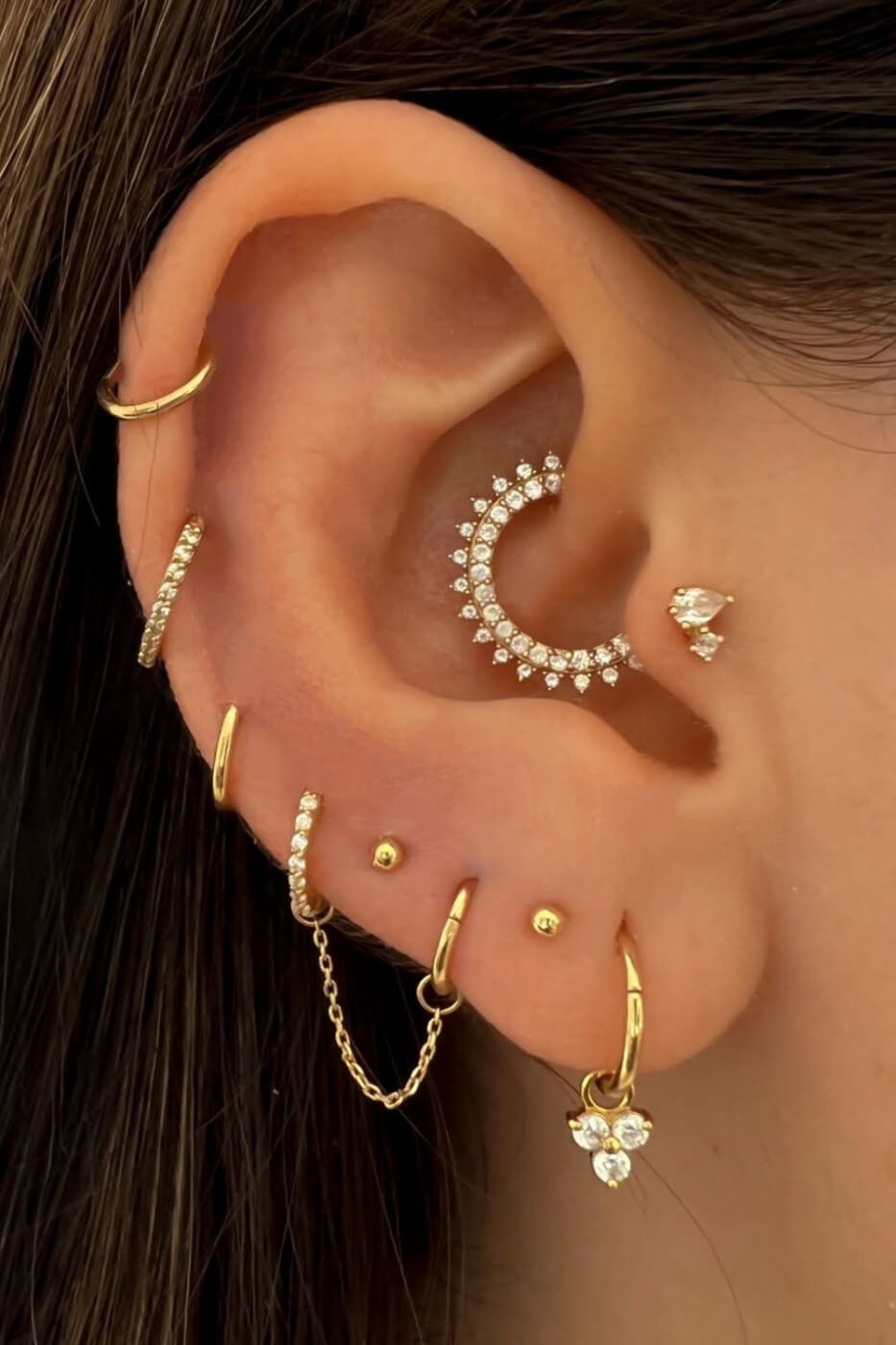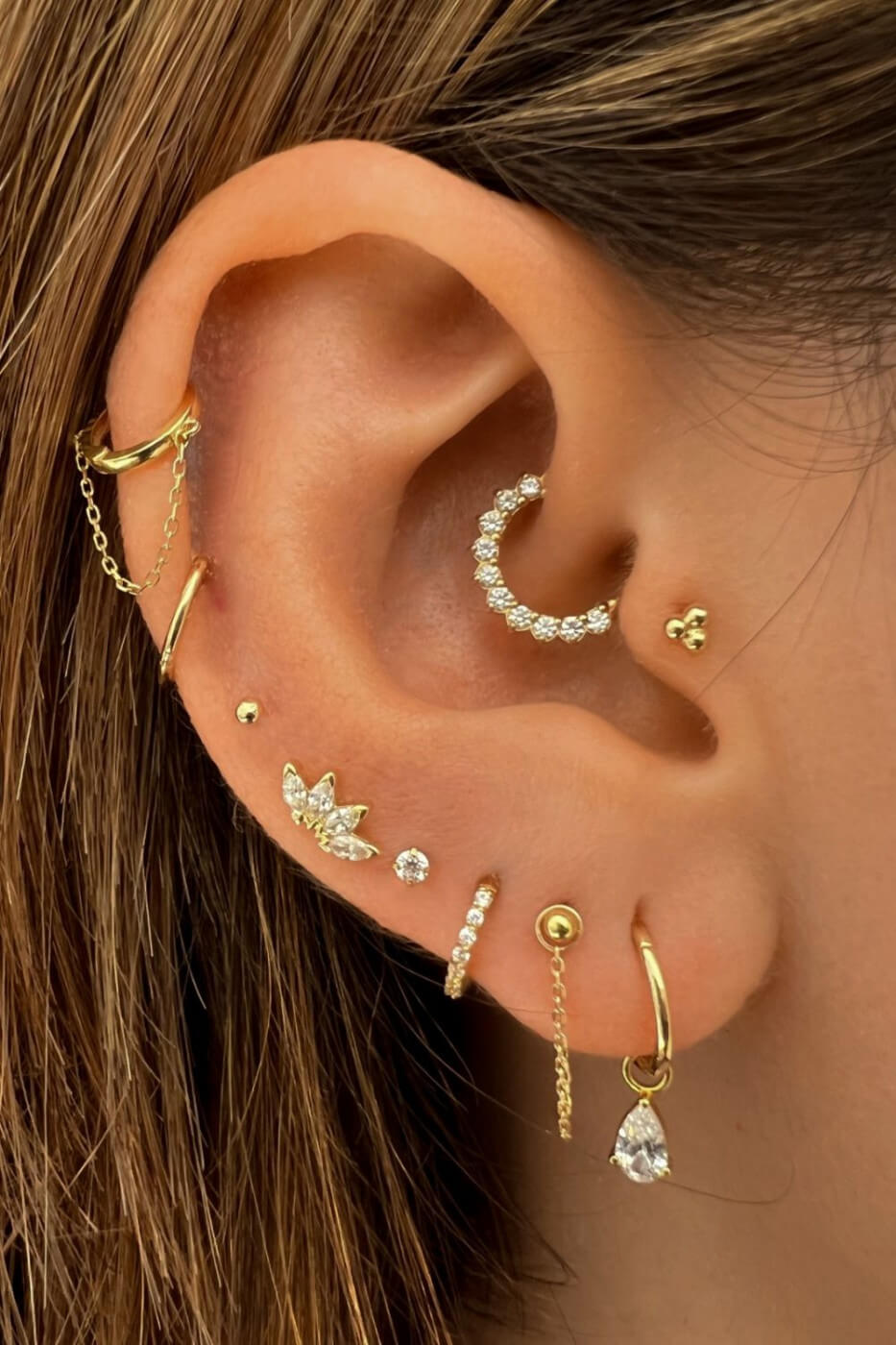Thinking about getting a cartilage piercing and leveling up your ear jewelry game? Here's everything you need to know, including the various styles to choose from, and what to expect while your cartilage piercing heals.
You have probably seen an ear with loads of earrings when scrolling through Instagram and Pinterest. For fashionistas, adding cartilage piercings to their ear adds a lot of personality to their style.
Cartilage ear piercings are one of the most popular types of body modifications. It’s fairly easy to get your cartilage pierced, and it can add a whole new level of coolness to your style. There are many different types of cartilage piercings, each with its own unique look. The most popular are tragus piercing, conch piercing, and helix piercing.
But before you get your new piercing, read this guide first! It will teach you everything you need to know about cartilage piercings, from the different types of piercings to aftercare.
What is a Cartilage Piercing?
Cartilage piercings are any piercings that go through the hard, non-bendy tissue, called cartilage, above your earlobe. Cartilage is much harder to pierce than the skin, so piercings usually take longer to heal.
But they're worth the wait—cartilage piercings are unique and more interesting than traditional lobe piercings, and they can really make your style stand out.
Types of Cartilage Piercings
Before we give you the full scoop on how to style your ear stack, let’s talk terminology. In this section, we’ll talk about the names of different ear piercings, where they are positioned on the ear, and which style of earring looks best in each type of piercing.
Ear Piercing Chart
Helix piercings
Let’s start at the top! A helix piercing is any piercing in the upper ear cartilage / outer edge of the ear. Stylish and classy, the helix piercing is one of the most common ear piercings out there, with many people getting multiple helix piercings, and goes particularly well with huggie hoop earrings.
READ HELIX PIERCING GUIDE
Conch piercing
Center of attention? Absolutely! Located in the inner part of your ear, a conch piercing is done through the thickest part of the ear's cartilage, just below the helix, and it's usually the center piece of any ear stack! There are two main regions of this middle cartilage: the inner conch and the outer conch piercing. Both studs and hoops look great in this eye-catching cartilage piercing.
READ CONCH PIERCING GUIDE
Tragus piercing
Located on the little flap of cartilage on the side of your face that covers the ear canal, the tragus piercing is one of the most versatile cartilage piercings. Can’t choose between a teeny tiny cartilage hoop or a flat-back earring? Get them both and alternate styles in your tragus!
READ TRAGUS PIERCING GUIDE
Daith piercing
If we were handing out superlatives for ear piercings, the daith piercing would win Most Loved! Located on the smallest fold of the cartilage in your ear canal, where the outer ridge of your ear meets your inner ear above the ear canal, the daith is one of the most fun piercings to style. We recommend starting with a statement piece for your daith, so you can build your ear stack around it.
READ DAITH PIERCING GUIDE
Rook piercing
Multiple looks, one rook! The rook piercing is located on the upper cartilage, between your outer and inner ear and above your tragus. This distinctive ear piercing looks great with a dainty cartilage hoop or a delicate, curved barbell.
READ ROOK PIERCING GUIDE
Industrial piercing
An industrial piercing is actually two piercings that are connected by a barbell. It's done through the cartilage on the top of the ear and is often worn as a decorative piercing.
READ INDUSTRIAL GUIDE
Forward Helix piercings
The forward helix piercing is located at the small outer rim of the cartilage at the top front of your ear, just above the ear canal. Flat back earrings are the most popular jewelry for this type of ear piercing, but don’t limit yourself! A small cartilage hoop also looks great in a forward helix piercing.
A forward helix piercing is a unique ear piercing that not many people have, but it can be a great way to make your ears stand out.
READ FORWARD HELIX GUIDE
Anti Tragus Piercing
We’ve talked about the tragus, now let’s learn about the anti tragus piercing. The anti-tragus is the relatively small vertical lip of cartilage above the earlobe and across from the tragus. We love styling this piercing with a curved barbell or huggie hoop, which goes through the fold of skin on the small, curved area above your earlobe.
READ ANTI TRAGUS GUIDE
Snug Piercing
Snuggles are great, but a snug piercing might be even better! A snug piercing is a horizontal piercing through the inner ridge of the ear cartilage that sits right above the anti-tragus. Snug piercings are unique and look beautiful with tiny huggie earrings or dainty curved barbells.
READ SNUG PIERCING GUIDE
Lobe Piercing
This is the piercing that started it all-- it's probably the first spot you got your ears pierced! Ear lobe piercings, as the name suggests, are piercings to the earlobe. We love lobe piercings because they’re (mostly) pain-free and have the quickest healing time. The sky is the limit when you have a lobe piercing in your ears. Choose flat back earrings, studs, huggie hoops, big hoops, drop earrings, and the list goes on and on!
READ LOBE PIERCING GUIDE
 |  |
How much does it cost to get a Cartilage piercing?
The price of a cartilage piercing will vary depending on the type of piercing, the jewelry you choose, and the studio's location. But on average, you can expect to pay between $40 and $100 for a simple cartilage piercing.
If you're getting a more complex piercing, such as an industrial or a rook piercing, the price will be closer to $100.
And if you're getting your piercing done at a high-end studio with top-of-the-line jewelry, you can expect to pay even more.
Pro-Tip: Don't be in a low price trap. When it comes to piercings, you get what you pay for. A cheap piercing from a shady studio is more likely to get infected and take longer to heal. It's worth spending a little extra to ensure your piercing is done right.
Pain and Healing time
How painful is a Cartilage piercing?
It totally depends on your pain tolerance and the type of ear piercing you're getting. But most people say that cartilage piercings are more painful than earlobe piercings.
On a scale of 1 to 10, with 10 being the most painful, most people say conch and rook piercings fall between 8 and 9. In contrast, helix piercings are one of the least painful types of cartilage piercings. They're usually only a 4 or 5 on the pain scale.
How long does a Cartilage piercing take to heal?
Cartilage piercings take longer to heal than earlobe piercings. The average healing time is 8 months, but it can take up to 12 months for some people.
The healing process is slow because cartilage doesn't have a good blood supply. This means that it's harder for the body to fight off infection and promote healing.
You can help your piercing heal faster by following these tips:
Clean your piercing twice a day with a saline solution or alcohol-free cleansing wipes.
Avoid touching your piercing with dirty hands.
Don't sleep on your piercing.
Don't remove your jewelry until your piercing is fully healed.
When can I change my Cartilage piercing jewelry?
You should wait at least three-to-six months before changing your cartilage piercing jewelry. This gives your piercing time to heal and reduces the risk of infection.
You may be able to change your jewelry sooner if your piercing is fully healed and you're careful. Talk to your piercer first to see if they're okay with you changing your jewelry early.
Why shouldn't you get a Cartilage piercing?
There are a few reasons why you might not want to get a cartilage piercing.
They're more painful than earlobe piercings. If you have low pain tolerance, you might want to stick with an ear lobe piercing.
They take longer to heal. If you're not patient, you might get frustrated with the slow healing process.
They're more likely to get a nasty infection. This is because cartilage doesn't have a good blood supply, which makes it harder for the body to fight off infection.
Aftercare
Caring for a new cartilage piercing is similar to caring for any other type of piercing. Like all piercings, there's a risk of infection, so it's important to clean your piercing regularly.
Gently clean your piercing twice a day with either the saline solution or the sea salt solution. Use a cotton swab or your finger to apply the solution to your piercing, then rinse with clean water. Avoid touching your piercing with dirty hands, and don't let anyone else touch it either.
If you have any signs of infection, such as redness, swelling, or discharge, see your doctor.
What should I do if my Cartilage piercing gets infected?
If you think your piercing may be infected, it's important to seek professional medical help as soon as possible. Infections can cause serious health complications if not treated properly.
Some signs of an infected piercing include:
Redness
Swelling
Pain
Pus(green or yellow) or crusty discharge
Pain or itching
Crusted over an area around the piercing
Heat around piercing area.
Unexpected fever
What if my Cartilage doesn't heal?
If your piercing isn't healing properly, it's essential to seek professional medical help. There are several things that can cause a piercing not to heal properly, and only a doctor will be able to give you the proper diagnosis and treatment.
Styling Cartilage piercings
 |  |
Where can I find jewelry for my Cartilage piercing?
I'm glad you asked! Assolari has an amazing collection of beautiful gold hoops and sparkling studs for your ear piercings. We never compromise on quality, but our prices are designed for those who want to look great without spending an entire paycheck to achieve it.
What size should I choose for my Cartilage piercing earring?
The most common size for a cartilage piercing is 16 gauge. This size is large enough to accommodate most people's healing process but small enough to minimize the risk of damage to the tissue.
Here's how to measure your Cartilage piercing:
The distance from the piercing hole to the outer edge of your ear is what you want to measure. This will give you the circumference of your ear.
Pro-Tip: Take the following measurement in a straight line; if you take it at a diagonal angle, you may get a hoop that is too large.
What material should be my Cartilage jewelry?
The best materials for cartilage jewelry are stainless steel, titanium, or 14k gold. These materials are non-reactive and hypoallergenic, making them ideal for people with allergies to metals.
I'm ready for another piercing! When can I get a new piercing ?
There are a few things to consider when thinking about what piercing to get next. The most important thing is to make sure that you are fully healed from your previous piercing before getting anything new done. Once you are sure that your body is ready, it is time to start thinking about what style you would like to go for next.
WANT US TO STYLE YOUR EAR?
If curating a luxurious ear stack is your goal, Assolari can help!
We’ve designed hundreds of ear stacks for customers, and we look forward to creating your dream stack, too! Just tell us about your piercings, personal style, and preferences, and we’ll put together an ear piercing stack we’re sure you’ll love! This service comes with a $60 voucher toward your next purchase, so don’t hesitate,book your consultation today!
Ear Styling Service
$120.00
Bring your dream ear stack to life! Ever wondered how to style the perfect ear stack? Or maybe what piercing should you get next? Well, Brunna is not your fairy godmother, but she can definitely help you figure it out!… read more
As an enthusiast with demonstrable knowledge in the field of body modifications, particularly cartilage piercings, I can share comprehensive insights into the concepts presented in the article. My expertise is grounded in a deep understanding of various types of piercings, their styles, the healing process, pain considerations, aftercare, and jewelry selection.
Cartilage Piercing Overview: A cartilage piercing involves puncturing the hard, non-bendy tissue above the earlobe. While these piercings take longer to heal than traditional lobe piercings, they offer a unique and stylish alternative.
Types of Cartilage Piercings:
- Helix Piercings: Positioned in the upper ear cartilage, it's versatile and pairs well with huggie hoop earrings.
- Conch Piercings: Located in the inner part of the ear, through the thickest cartilage, it serves as a centerpiece for ear stacks.
- Tragus Piercings: Placed on the little flap of cartilage covering the ear canal, allowing for versatile styling with various earring types.
- Daith Piercings: Found in the smallest fold of cartilage in the ear canal, it's a fun piercing to style, often recommended for statement pieces.
- Rook Piercings: Situated on the upper cartilage between the outer and inner ear, ideal for dainty cartilage hoops or curved barbells.
- Industrial Piercings: Comprising two piercings connected by a barbell, usually done through the top cartilage of the ear.
- Forward Helix Piercings: Located at the small outer rim of the cartilage at the top front of the ear, allowing for unique and standout styling.
- Anti-Tragus Piercings: Placed on the vertical lip of cartilage above the earlobe, often styled with curved barbells or huggie hoops.
- Snug Piercings: A horizontal piercing through the inner ridge of the ear cartilage, situated above the anti-tragus, perfect for tiny huggie earrings or curved barbells.
- Lobe Piercings: The traditional earlobe piercing, offering versatility with various earring styles.
Cost of Cartilage Piercing: The cost varies based on the type of piercing, chosen jewelry, and studio location. On average, simple cartilage piercings range from $40 to $100, with more complex ones like industrial or rook piercings costing around $100.
Pain and Healing Time: Pain levels depend on personal tolerance, with conch and rook piercings often rated between 8 and 9 on a scale of 1 to 10. Cartilage piercings take 8 to 12 months to heal due to the limited blood supply in cartilage.
Changing Jewelry and Risks: Wait at least three to six months before changing cartilage piercing jewelry to ensure proper healing and reduce infection risks. Consult with a piercer before changing jewelry early.
Reasons to Avoid Cartilage Piercing: Considerations include higher pain levels, longer healing times, and an increased risk of infection due to cartilage's limited blood supply.
Aftercare: Regular cleaning with saline or alcohol-free wipes, avoiding dirty hands contact, and not removing jewelry until fully healed are essential aftercare practices.
Dealing with Infections: Professional medical help is crucial if signs of infection, such as redness, swelling, pain, pus, or itching, occur.
Choosing Cartilage Jewelry: Opt for materials like stainless steel, titanium, or 14k gold, as they are non-reactive and hypoallergenic. The common size for cartilage piercing is 16 gauge.
Getting Additional Piercings: Wait until previous piercings are fully healed before considering new ones. Consider personal style and preferences when choosing the next piercing.
Ear Styling Services: Assolari offers an ear styling service to curate a luxurious ear stack based on individual piercings, style, and preferences, providing a $60 voucher toward the next purchase.
By combining a wealth of knowledge on these topics, I aim to empower individuals considering cartilage piercings with the information needed to make informed decisions and care for their piercings effectively.



